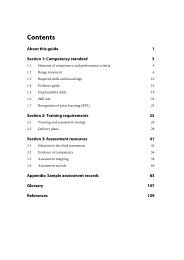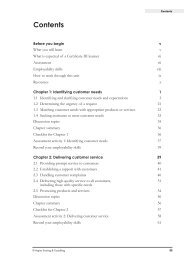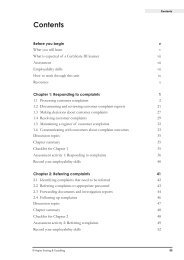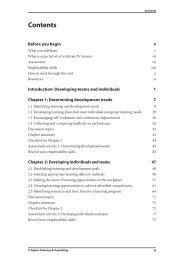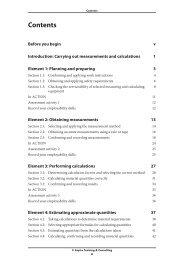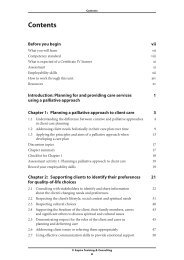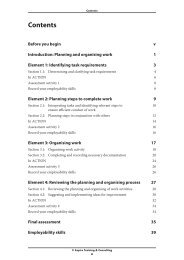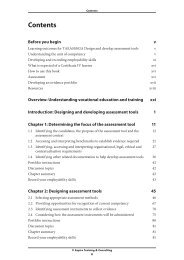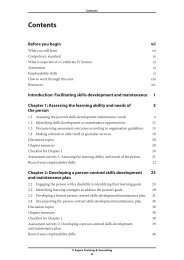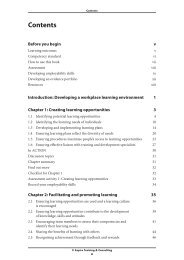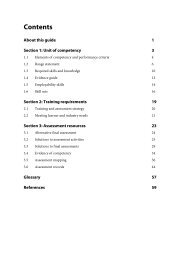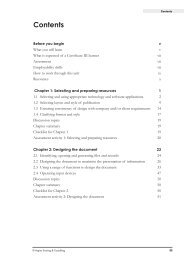view sample - Aspire Learning Resources
view sample - Aspire Learning Resources
view sample - Aspire Learning Resources
You also want an ePaper? Increase the reach of your titles
YUMPU automatically turns print PDFs into web optimized ePapers that Google loves.
Contents<br />
About this guide 1<br />
Section 1: Competency standard 3<br />
1.1 Elements of competency and performance criteria 4<br />
1.2 Range statement 6<br />
1.3 Required skills and knowledge 8<br />
1.4 Evidence guide 13<br />
1.5 Employability skills 16<br />
1.6 Skill sets 19<br />
1.7 Recognition of prior learning (RPL) 20<br />
Section 2: Training requirements 21<br />
2.1 Training and assessment strategy 22<br />
2.2 Delivery plans 24<br />
3.1 Solutions to the final assessment 36<br />
3.2 Evidence of competency 49<br />
3.3 Assessment mapping 51<br />
3.4 Assessment records 59<br />
Appendix: Sample assessment records 75<br />
Glossary 99<br />
References 103
About this guide<br />
This guide is for trainers and assessors of unit TAEASS403A Participate in assessment<br />
validation from the TAE10 Training and Education Training Package. It complements<br />
the corresponding <strong>Aspire</strong> learner workbook.<br />
As a trainer, you must develop and use training and assessment strategies that embrace<br />
the learner’s needs, educational background, preferred learning style and meet the<br />
requirements of the training package.<br />
This guide provides ideas on how you can encourage and support learners through the<br />
training and assessment process. It is designed to optimise the learner’s experience of<br />
TAEASS403A Participate in assessment validation and record details of their competency.<br />
The guide is divided into six sections:<br />
Section 1:<br />
Section 2:<br />
Section 3:<br />
Appendix:<br />
Glossary<br />
References<br />
Competency standard<br />
Training requirements<br />
Assessment resources<br />
Sample assessment records<br />
How to use <strong>Aspire</strong>’s learner workbooks<br />
<strong>Aspire</strong>’s learner workbooks are structured to meet the requirements of the unit of<br />
competency. The learner workbook’s preliminary pages include:<br />
information on the unit of competency<br />
learning outcomes required for Certificate IV learners, including the required skills<br />
and knowledge for the competency<br />
components of the workbook and how to work through it<br />
assessment information<br />
employability skills information<br />
how to develop an evidence portfolio<br />
additional learning resources.<br />
© <strong>Aspire</strong> Training & Consulting 1
Section 1:<br />
Competency standard<br />
The TAE10 Training and Education Training Package was developed by the Innovation<br />
and Business Skills Australia Industry Skills Council in consultation with industry<br />
stakeholders including individuals and organisations within the vocational education and<br />
training sector, employers, unions, peak bodies, professional associations, regulatory<br />
bodies, registered training organisations (RTOs) and other relevant parties. The training<br />
package specifies the skills and knowledge required for training and education in the<br />
vocational education and training environment.<br />
Individual units of competency are nationally agreed statements that describe work<br />
outcomes and can stand alone when applied in the workplace.<br />
This section outlines the requirements of the unit of competency for TAEASS403A<br />
Participate in assessment validation.<br />
Section one contains the following information:<br />
1.1 Elements of competency and performance criteria<br />
1.2 Range statement<br />
1.3 Required skills and knowledge<br />
1.4 Evidence guide<br />
1.5 Employability skills<br />
1.6 Skill sets<br />
1.7 Recognition of prior learning (RPL)<br />
© <strong>Aspire</strong> Training & Consulting 3
1.5 Employability skills<br />
The Employability Skills Framework (2002) developed by the Australian Chamber of<br />
Commerce and Industry and the Business Council of Australia lists the employability<br />
skills. They are:<br />
communication<br />
teamwork<br />
planning and organising<br />
initiative and enterprise<br />
problem-solving<br />
self-management<br />
technology<br />
learning.<br />
Training packages now have employability skills embedded into each unit of competency.<br />
As the trainer, you should understand the range of employability skills and how you can<br />
assist the learner to develop them. Make sure all learners are familiar with employability<br />
skills. It is your job to know where they are embedded.<br />
You should explain the importance of having these skills to the learner and that these<br />
skills will develop as the learner goes about their daily work or when they practise the<br />
activities in the workbook. Help the learner to read the employability skills section at the<br />
front of the <strong>Aspire</strong> workbook.<br />
Identify how the learner can demonstrate they have acquired the skills. Encourage the<br />
learner to think about employability skills each time they complete a chapter in the <strong>Aspire</strong><br />
workbook. Ask them to complete the employability skills table after the final assessment.<br />
Learners should document what they did to develop each employability skill. They may<br />
describe some work or task they completed. For example, they may describe or<br />
demonstrate how they created their work area or tell you how they solved a problem.<br />
Employability skills summary for TAE40110 Certificate IV in<br />
Training and Assessment<br />
The following table contains a summary of the employability skills required by industry<br />
for this qualification. The employability skills facets described here are broad industry<br />
requirements that may vary depending on qualification packaging options.<br />
16 © <strong>Aspire</strong> Training & Consulting
2.1 Training and assessment strategy<br />
Training organisations must develop a training and assessment strategy for all their<br />
training programs. The training and assessment approach adopted by RTOs must accord<br />
with the learner’s needs, current workplace contexts and the requirements of the training<br />
package.<br />
RTOs must comply with the AQTF standards, which means they must:<br />
■ meet the requirements of the training package including language, literacy and<br />
numeracy requirements<br />
■ document information according to AQTF audit requirements<br />
■ meet the needs of particular target groups<br />
■ provide learning pathways<br />
■ seek input from industry and other relevant stakeholders.<br />
Structuring a training program<br />
The following checklist outlines the type of information you may wish to include in your<br />
training and assessment strategy.<br />
Details of the training organisation including contact person<br />
The unit/s of competency to be delivered in the program of study<br />
Pathways<br />
The learner or target group<br />
Delivery mode/s<br />
Training resources including facilities required for delivery and assessment, and<br />
other infrastructure requirements<br />
Methods of assessment and evidence gathering<br />
Program duration and delivery schedule<br />
Session locations including workplace assessment information<br />
Delivery and assessment staff<br />
Assessment validation process<br />
22 © <strong>Aspire</strong> Training & Consulting
2.2 Delivery plans<br />
The following delivery plans can be used to deliver TAEASS403A Participate in<br />
assessment validation. These plans, including the time allocations, are suggestions only.<br />
You may need to add to them, change them or substitute your own activities according to<br />
the interest level, experience of the learners and the specific situation.<br />
Remember; it is your responsibility as the trainer to use the most appropriate strategies<br />
for your learners. In some situations you may choose face-to-face delivery, while in other<br />
circumstances online delivery may be more appropriate.<br />
Topic: Preparing for validation<br />
Suggested time allocation: 12 hours<br />
Suggested resources:<br />
Recommended reading<br />
Slide-presentation software<br />
Slide nos: 2–28<br />
Recommended reading<br />
<strong>Aspire</strong> workbook TAEASS403A Participate in<br />
assessment validation<br />
Chapter 1: Preparing for validation<br />
AQTF Essential conditions and standards for initial<br />
registration<br />
AQTF Essential conditions and standards for<br />
continuing registration<br />
Terminology checklist<br />
Validation<br />
Moderation<br />
Competency-based training<br />
Recognition of prior learning<br />
Validation approach<br />
Sampling<br />
Compliance<br />
Continuous improvement<br />
Benchmarking criteria<br />
Criterion-referenced assessment<br />
Evidence-based assessment<br />
Norm-referenced assessment<br />
Formative assessment<br />
Summative assessment<br />
Evidence guide<br />
Assessment guidelines<br />
24 © <strong>Aspire</strong> Training & Consulting
that other panel members consider unreasonable or impractical. For example, the industry<br />
representative may not agree with the provisions for reasonable adjustment or may believe that the<br />
attempts by the RTO to write instructions at an appropriate LLN level for candidates has ‘dumbeddown’<br />
the assessment so that it does not accurately reflect workplace practices.<br />
<br />
<br />
<br />
<br />
<br />
Learners should use their journal to critically reflect on their contribution to the discussion of validation<br />
findings. The following questions may be used to focus their reflective statement:<br />
−<br />
−<br />
−<br />
−<br />
−<br />
What outcomes were achieved<br />
What recommendations are the panel making<br />
How will these recommendations contribute to the quality of assessment processes<br />
What conflict, challenges or issues were encountered in the discussion<br />
How were these addressed<br />
Learners should complete learning tasks 7 and 8 before they undertake the journaling activity.<br />
Learners may refer to their critical reflection as they undertake learning in section 3.3. Qualified<br />
assessors are expected to make a commitment to ongoing professional development and continuous<br />
improvement of their work practices. Journaling, regular critical reflection, the use of a critical friend,<br />
mentoring and participating in communities of practices and membership of professional associations<br />
are potential sources of professional development. Learners will find in section 3.3 a detailed<br />
explanation of how the conduct of validation processes may also contribute to improvements in their<br />
assessment practice.<br />
Facilitate a brainstorming session where participants list potential changes to assessment practices for<br />
individual assessors that could be identified during validation. Learners should reflect on whether any<br />
of the listed issues are applicable to their performance in the various validation activities they have<br />
undertaken as they have progressed through the workbook.<br />
You could also have learners prepare a mind map of the various sources of information and<br />
guidance that they could refer to when developing strategies for improving their practice.<br />
<strong>Learning</strong> task 9 is designed to synthesise learning in the workbook by asking learners to formalise<br />
their commitment to participation in quality processes and validation activities by preparing a<br />
professional development plan. It would be beneficial to learners if they were to obtain feedback on<br />
their professional development plan before adding it to their assessment portfolio. You should check<br />
the professional development plan to ensure that they have suggested future actions to improve their<br />
assessment practice.<br />
Revision tasks<br />
<strong>Learning</strong> activities 7–9<br />
© <strong>Aspire</strong> Training & Consulting 33
3.1 Solutions to the final assessment<br />
Part A<br />
Trainers should observe learners demonstrating the required skills and record their<br />
observations in the assessment record provided in section 3.4.<br />
Part B<br />
Answers may vary.<br />
1. a) Purposes for the validation could include:<br />
<br />
<br />
<br />
<br />
<br />
to re<strong>view</strong> all aspects of the organisation’s assessment system<br />
to ensure compliance with AQTF Essential Conditions and Standards for<br />
Registration<br />
to re<strong>view</strong> assessment methods and tools used to gather evidence of<br />
competency to check that assessment processes are valid, fair, flexible and<br />
reliable<br />
to check that the evidence gathered is valid, sufficient, current, authentic in<br />
order to make a judgment on competence<br />
to ensure that assessors working across multiple sites are applying consistent<br />
standards and making reliable judgments.<br />
b) A properly conducted validation process can benefit you as an assessor by:<br />
<br />
<br />
<br />
helping improve assessment practice of individual assessors<br />
ensuring continuous improvement<br />
contributing to enhanced relationships with stakeholders.<br />
2. The learner must have described the process that they follow to read and interpret a<br />
competency standard in order to identify the required evidence and assessment<br />
methods. Individual responses will vary. Check that in their response, the candidate<br />
explains a process that involves understanding the application of the unit and<br />
visualising competence; for example:<br />
<br />
<br />
read and interpret the application of the unit<br />
read the elements and performance criteria and consider how to integrate them<br />
for assessment<br />
36 © <strong>Aspire</strong> Training & Consulting
3.2 Evidence of competency<br />
Evidence is information gathered that provides proof of competency. While evidence<br />
must be sufficient, trainers and assessors must focus on quality evidence rather than the<br />
quantity of evidence.<br />
Rules of evidence<br />
There are four rules of evidence that guide the collection of evidence. Evidence must be:<br />
valid – it must cover the required skills and knowledge<br />
sufficient – it must be enough to satisfy the competency<br />
current – skills and knowledge must be up to date<br />
authentic – it must be the learner’s own work and supporting documents must be<br />
genuine.<br />
Principles of assessment<br />
High quality assessments must be:<br />
■ fair – assessments are not discriminatory or disadvantage the candidate<br />
■ flexible – assessments meet the candidate’s needs and include an appropriate range of<br />
assessment methods<br />
■ valid – assessments assess the unit/s of competency required skills and knowledge<br />
■ reliable – there is a common interpretation of the assessments.<br />
Types of evidence<br />
Types of evidence that can be collected, sighted or validated include:<br />
work records such as completed templates and proformas, checklists, prepared<br />
assessment tools, learning programs<br />
third-party reports from candidates, managers and/or supervisors<br />
training records and other recognised qualifications<br />
skills and knowledge assessments<br />
© <strong>Aspire</strong> Training & Consulting 49
Gathering evidence<br />
Evidence can be gathered through:<br />
real work/real-time activities through observation and third-party reports<br />
structured activities.<br />
Evidence can also be gathered through:<br />
■ formative assessments: where assessment is progressive throughout the learning<br />
process and validated along the way by the trainer – also known as assessment for<br />
learning<br />
■ summative assessment: where assessment is an exercise or simulation at the end of<br />
the learning process – also known as assessment of learning.<br />
Evaluating evidence<br />
The following steps may help you evaluate evidence.<br />
Step 1: Evidence is gathered.<br />
Step 2: Rules of evidence are applied –<br />
evidence is valid, sufficient, current and authentic.<br />
Step 3: Evidence meets the full requirements of the<br />
unit/s of competency.<br />
Step 4: The assessment process is valid, reliable, fair and<br />
flexible.<br />
Step 5: The trainer or assessor makes a straightforward and<br />
informed judgment about the candidate and completes<br />
assessment records.<br />
50 © <strong>Aspire</strong> Training & Consulting
3.3 Assessment mapping<br />
Methods of assessment mapped to the workbook<br />
Assessment methods are the particular techniques used to gather different types of<br />
evidence. The mix of evidence gathered to demonstrate competency is dependent on the<br />
context of the assessment and the background of the candidate.<br />
The following table outlines the different methods of assessment used in the <strong>Aspire</strong><br />
learner workbook TAEASS403A Participate in assessment validation.<br />
Assessment method <strong>Learning</strong> activity Final assessment<br />
Question/answer 8 Part B<br />
Observation/demonstration 4, 7 Part A<br />
Case study 6 Part C<br />
Role-play<br />
Training log, diary or journal 9<br />
Portfolio, reports, work<br />
<strong>sample</strong>s<br />
1, 2, 3, 5 Part D<br />
Third-party reports<br />
© <strong>Aspire</strong> Training & Consulting 51
Required knowledge checklist<br />
Institution:<br />
Candidate’s name:<br />
Unit of competency: TAEASS403A Participate in assessment validation<br />
Trainer/assessor:<br />
Date:<br />
Did the candidate show their knowledge of: Yes No N/A<br />
<br />
How to interpret competency standards and other related<br />
assessment information to determine the evidence needed to<br />
demonstrate competence, including:<br />
– criterion-referenced assessment as distinct from normreferenced<br />
assessment<br />
– various reasons for carrying out validation and the different<br />
approaches to validation that may be appropriate before,<br />
during and after assessment<br />
– critical aspects of validation, including validation of<br />
assessment processes, methods and products<br />
– relevant OHS legislation, codes of practice, standards and<br />
guidelines, impacting on assessment<br />
– legal and ethical requirements of assessors, particularly in<br />
relation to validation activities<br />
<br />
Principles of assessment <br />
Rules of evidence <br />
In the assessment/s of the candidate’s required knowledge, did they demonstrate the four<br />
dimensions of competency<br />
Task skills<br />
<br />
Task management skills<br />
<br />
Contingency management skills<br />
<br />
Job/role environment skills<br />
<br />
The candidate’s performance was:<br />
Not satisfactory Satisfactory<br />
© <strong>Aspire</strong> Training & Consulting 67



